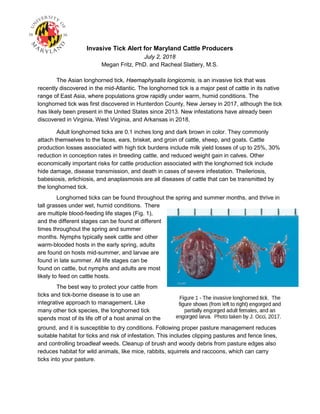
Invastive Tick Alert
- 1. Invasive Tick Alert for Maryland Cattle Producers July 2, 2018 Megan Fritz, PhD. and Racheal Slattery, M.S. The Asian longhorned tick, Haemaphysalis longicornis, is an invasive tick that was recently discovered in the mid-Atlantic. The longhorned tick is a major pest of cattle in its native range of East Asia, where populations grow rapidly under warm, humid conditions. The longhorned tick was first discovered in Hunterdon County, New Jersey in 2017, although the tick has likely been present in the United States since 2013. New infestations have already been discovered in Virginia, West Virginia, and Arkansas in 2018. Adult longhorned ticks are 0.1 inches long and dark brown in color. They commonly attach themselves to the faces, ears, brisket, and groin of cattle, sheep, and goats. Cattle production losses associated with high tick burdens include milk yield losses of up to 25%, 30% reduction in conception rates in breeding cattle, and reduced weight gain in calves. Other economically important risks for cattle production associated with the longhorned tick include hide damage, disease transmission, and death in cases of severe infestation. Theileriosis, babesiosis, erlichiosis, and anaplasmosis are all diseases of cattle that can be transmitted by the longhorned tick. Longhorned ticks can be found throughout the spring and summer months, and thrive in tall grasses under wet, humid conditions. There are multiple blood-feeding life stages (Fig. 1), and the different stages can be found at different times throughout the spring and summer months. Nymphs typically seek cattle and other warm-blooded hosts in the early spring, adults are found on hosts mid-summer, and larvae are found in late summer. All life stages can be found on cattle, but nymphs and adults are most likely to feed on cattle hosts. The best way to protect your cattle from ticks and tick-borne disease is to use an integrative approach to management. Like many other tick species, the longhorned tick spends most of its life off of a host animal on the ground, and it is susceptible to dry conditions. Following proper pasture management reduces suitable habitat for ticks and risk of infestation. This includes clipping pastures and fence lines, and controlling broadleaf weeds. Cleanup of brush and woody debris from pasture edges also reduces habitat for wild animals, like mice, rabbits, squirrels and raccoons, which can carry ticks into your pasture.
- 2. Early detection of ticks is key to preventing ill-effects of infestation. Cattle should be examined for ticks regularly throughout the course of the season. When ticks are detected, rotational grazing can limit tick population growth over the course of a summer season. Calves are most susceptible to tick feeding, so reducing their contact with dense pasture reduces tick burden and risk of tick-borne infection. Whole animal insecticide treatments, like Permectrin™ II and Ultra Boss™, can be used to prevent new tick attachment, but are less effective at eliminating ticks that are already attached. Sprays and pour-on treatments cannot be used alone for comprehensive livestock protection. An integrative approach to tick management, which combines pasture management with good husbandry and chemical prophylaxis is crucial for livestock protection. If you find ticks on your animal and you are concerned: 1. Collect a few of the ticks by tweezing them from the skin of your animal. They are most easily removed by grasping the tick close to the skin of the animal using a pair of blunt-ended tweezers, then gently pulling on them at a 45 degree angle from the animal’s skin. Once removed, immediately stick them to a piece of masking tape, and place them into a ziploc bag with a moist paper towel. Tick collections can be taken to your local University of Maryland Extension office or shipped directly to: Dr. Megan Fritz 4291 Field House Dr. Plant Sciences Building Rm. 4112 College Park, MD 20742 2. Call your University of Maryland Beef Cattle Specialist, Racheal Slattery, at 301-405-1392, or your University of Maryland Medical and Veterinary Entomologist, Megan Fritz, at 301-405-3945. 3. Call your local veterinarian and alert them to your tick infestation. Many veterinarians in the state of Maryland are working with the Maryland Department of Agriculture to address stakeholder concerns regarding the long-horned tick. The University of Maryland, College Park, will not discriminate against any person because of race, age, sex, color, sexual orientation, physical or mental disability, religion, ancestry or national origin, marital status, genetic information, political affiliation, and gender identity or expression.
